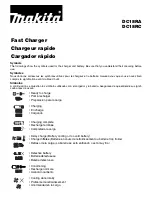
32
Discharging programme “DISCHARGE”
The discharging programme reduces the possible memory effect that occurs in rechargeable
batteries that are only recharged and thus lose capacity.
The discharging programme discharges the rechargeable battery completely, permitting
controlled and complete charging in the charging programme “CHARGE”. The discharged
capacity is displayed in “mAh”. To protect Ni-Cd/NiMH rechargeable batteries, the maintenance
charge is switched.
Conditioning programme “DISCHARGE REFRESH”
The conditioning programme refreshes and optimises bad rechargeable batteries by multiple
charge and discharge cycles. The programme will perform 3 complete charge and discharge
cycles. Depending on rechargeable battery status, set charge/discharge currents and the
rechargeable battery capacity, this programme may take anywhere from 10 hours to several
days. The capacity is displayed in “mAh” after each cycle, before a new cycle starts.
Test programme “CHARGE TEST”
The test programme permits review of the present rechargeable battery capacity.
The test programme charges the rechargeable battery fully first (CHARGE TEST) and
then starts to discharge it (DISCHARGE TEST). After the discharge cycle, the measured
discharge capacity in “mAh” is displayed and the rechargeable battery is fully charged again.
If the measured capacity is much lower than the indicated rated capacity, this may suggest
that the rechargeable battery has reached the end of its service life. If required, perform the
conditioning programme “DISCHARGE REFRESH” to revive the rechargeable battery. After
the rechargeable battery programme is completed, “FuLL” is displayed. For Ni-Cd/NiMH
rechargeable batteries, the maintenance charge is switched.
Quick test programme “QUICK TEST”
The test programme determines the dynamic interior resistance of the rechargeable battery.
The lower the interior resistance, the higher the current the rechargeable battery can absorb
and deliver. The interior resistance should be <500 mΩ for high-performance devices. If this
value is exceeded, the rechargeable battery should only be used for devices with a low current
consumption. When using rechargeable batteries, always ensure that the interior resist-
ance of all concurrently used rechargeable batteries is roughly the same. This increases the
performance of the entire unit.
The measured value strongly depends on contact quality. For clean contacts, a transfer
resistance of approx. 30 milliohm is included in the calculation. A deviation of up to
20% at multiple measurements is normal and does not suggest malfunction. When
measuring several times, use the average value.
















































